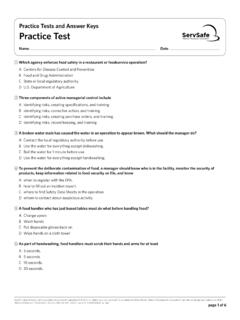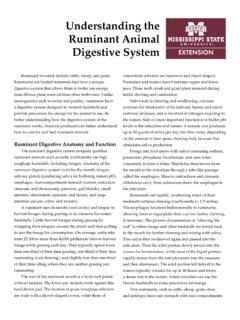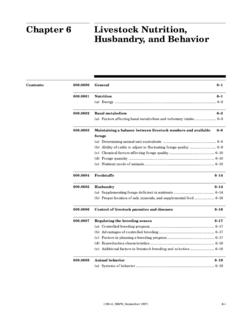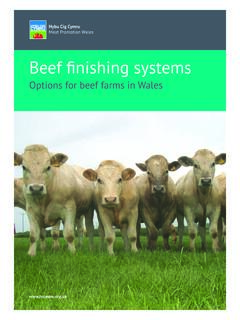Transcription of Hay Calculator for Livestock Producers
1 Hay Calculator for Livestock ProducersExcel Program (V2019) Instruction SheetWinter feeding costs make up a large portion of production costs for Mississippi Livestock Producers . This Excel-based program will help you evaluate hay feeding delivery systems and their economic impacts. It should provide an accurate estimate of the amount of hay needed for winter feeding as well as the necessary supplementation if hay is not meeting the nutrient requirements of a specific Livestock is essential you estimate how much hay you need for a specific feeding period to ensure animal feeding requirements are met. Not providing the necessary levels of crude protein (CP) and total digestible nutrients (TDN) could affect animal performance and may cause economic losses.
2 The hay Calculator is based on different classes of Livestock produced in Mississippi and will require a hay test to determine the nutritional value of the hay being hay Calculator is compatible with Excel 93-2007. To download the hay Calculator , visit and look for the publication file labeled To use the hay Calculator , follow these instructions: Make sure the macro function in your computer is enabled. You can change macro security settings in the Trust Center, unless a system administrator in your organization has changed the default settings to prevent you from changing the settings. On the Developer tab, in the Code group, click Macro Security. If the Developer tab is not displayed, click the Microsoft Office Button, click Excel Options, and then, in the Popular category, under Top Options for Working with Excel, click Show Developer tab in the Ribbon.
3 In the Macro Settings category, under Macro Settings, click the option you want. Any changes you make in the Macro Settings category in Excel apply only to Excel and do not affect any other Microsoft Office program. You can also access the Trust Center in the Excel Options dialog box. Click the Microsoft Office Button, and then click Excel Options. In the Trust Center category, click Trust Center Settings, and then click the Macro Settings Requirements CalculationStep 1. Enter the personal information that will help to create a report for record-keeping purposes. Put that information in the yellow highlighted section of the Excel sheet. A reset button at the top left corner of the sheet allows you to reset the values once you have printed the calculations and 2.
4 A forage quality analysis is required for a more accurate estimate of the amount of nutrients available to meet Livestock nutrient requirements. For information related on how to collect a hay sample, please refer to Publication 2539 at Send hay samples requiring analysis to the Mississippi State Chemical Laboratory:Mississippi State Chemical Box CRMississippi State, MS 39762 Phone: (662) 325-3428 Fax: (662) 325-7807 (click Forage Analysis Test Request Form & Limitations Form)Step 3. You will need to get an inventory of the hay that is available: number of round or square bales and average weight per bale. This helps in determining the amount of hay that is available. It will be beneficial to get the weight of at least 5 to 10 bales within the same lot to estimate the average bale weight in 4.
5 This step defines how long you plan to feed hay and how much hay loss you will have, based on storage and feeding methods. Feeding days: How many days you plan to feed hay. This lets you determine if there is a hay surplus or deficiency. Depending on how you store and feed hay, you always have hay losses. Storage losses (Table 1): Estimated values based on type of storage and how long the hay is stored under those conditions gives you values to put into the calculation sheet. Feeding losses: Animals can cause hay losses. Table 2 shows sample ranges in feeding 5. Select the type(s) of Livestock that will be hay-fed on the farm: Know the right number of animals that will be fed.
6 Know the average weight per animal in pounds to calculate the metabolic weight. Calculate daily dry matter intake (lb/day) based on the metabolic weight of the animal and adjust based on the crude protein and neutral detergent of the hay. Hay test report: The percent dry matter as received. This will let you calculate what percent of that dry matter is moisture and will be used to adjust daily hay fed. Daily hay fed: Amount of hay needed for each Livestock and adjusted for nutrient requirement and losses. Total hay need: Amount of hay need (in tons) to feed a specific number of animals for a specific time. Nutrient requirement: Determines if the hay meets the nutrient requirements of the Livestock .
7 If it doesn t, you will need to supplement. If numbers are in red for crude protein (CP) or total digestible nutrients (TDN), you need to supplement. If numbers are in green, nutrient requirements are met or there is a surplus. Table 3 provides the nutrient requirements for each Livestock class that need to be met with hay or feed 6. Hay surplus/deficiency: Based on the total hay needed for a specific feeding time frame. If numbers are red, you need to buy hay. If numbers are green, there is sufficient hay or a 7. Hay cost analysis lets you calculate how much hay you need, if there is a deficiency of hay, and how much the hay costs. You will need to know the average weight of the bales and the price per bale you will buy in case you need extra , , Zanella, Harrigan, Van Lente, Gnagey, and Kaercher.
8 2003. Large round bale feeder design affects hay utilization and beef cow behavior. J. Anim. Sci. 81: , 1994. Nutrient requirements of sheep and goats. Alabama Coop. Ext. Serv. , 2003. Round bale hay storage. Oklahoma State Coop. Ext. Serv. , R., S. Porr, and J. Cardina. Horse Nutrition. Ohio State Coop. Ext. Serv. Bulletin 762-00. Online: (Accessed May 15, 2009).Lalman, D. and C. Richards. 2006. Oklahoma State University Feed Commodity Bulletin: Nutrient composition table. Oklahoma State University. Online: (Accessed August 14, 2009).National Research Council (NRC). Nutrient requirements for beef cattle. 2000. National Academic 1. Hay losses under different storage 912 18 RangeAverageRangeAverageStorageMethod% LossesOutsideNot CoveredGround5 roof2 : Huhnkle, , 2.
9 Hay losses based on feeding Hay Feeding LossesFeeder TypeRangeAverageCone0 42 Cradle5 1510 Ground10 289 Ring0 63 Trailer5 116 Trough8 206 Source: Buskirk et al., 3. Daily nutrient requirements for TypeCPTDNC alciumPhosphorusVitamin A%(% ration)(IU/lb)CattleRep. heifers heifers 1st calf 1st calf brood yearling steers, 700 900 lb, medium yearling steers, 800 1000 lb, large yearling heifers, 600 800 lb, medium yearling heifers, 700 900 lb, large cows, 900 1000 lb, moderate cows, 1100 1300 lb, moderate cows, 1300 1500 lb, moderate cows, 900 1000 lb, high cows, 1100 1300 lb, high cows, 1300 1500 lb, high cows 1000 lb, 50% forage , mature , mares , mares , mares 1st 3 months , mares , weanlings 4 6 , weanlings 6 12 , yearlings 12 18 , 18 24 , light , moderate , heavy , 2590 (POD-11-19)
10 By Rocky Lemus, PhD, Extension/Research Professor, Plant & Soil Sciences; and Daniel Rivera, PhD, Associate Extension/Research Professor, South Mississippi Branch Experiment information is for educational and preliminary planning purposes only. Use this program as a guide only. The hay Calculator uses publicly available information as a basis for its calculations; such information may change over time. The user assumes the risk of using or otherwise relying upon any hay Calculator output. The hay Calculator does not provide supplementation TypeCPTDNC alciumPhosphorusVitamin A%(% ration)(IU/lb)SheepMature , winter lamb , May lamb (140% lamp crop) , May lamb (180% lamp crop) , lactating (suckling singles) , lacatating (suckling twins) ewe lambs doe with kid to , 700 : Gimenez, 1994; NRC, 2000; Kline et al.
















